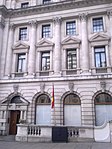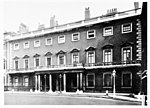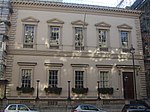British Columbia House
British Columbia stubsCultural infrastructure completed in 1915Grade II listed buildings in the City of WestminsterLondon building and structure stubsUnited Kingdom listed building stubs ... and 1 more
Use British English from September 2014

British Columbia House is a Grade II listed building at 1 and 3, Regent Street, Westminster, London.Designed by architect Alfred Barr, British Columbia House was constructed in 1914 as the premises of the Agent-General of the Province of British Columbia, a position then held by John Herbert Turner. At the time of the building's official opening, in 1915, Turner had been replaced by Richard McBride, but McBride's death, in 1917, saw him return to the Agent-General's role.The building is owned by the Crown Estate and is now a commercial building. It underwent a £8.5 million refurbishment in 2013.
Excerpt from the Wikipedia article British Columbia House (License: CC BY-SA 3.0, Authors, Images).British Columbia House
Regent Street St James's, City of Westminster Covent Garden
Geographical coordinates (GPS) Address Nearby Places Show on map
Geographical coordinates (GPS)
| Latitude | Longitude |
|---|---|
| N 51.508111111111 ° | E -0.13352777777778 ° |
Address
Regent Street St James's 3
SW1Y 4NR City of Westminster, Covent Garden
England, United Kingdom
Open on Google Maps








